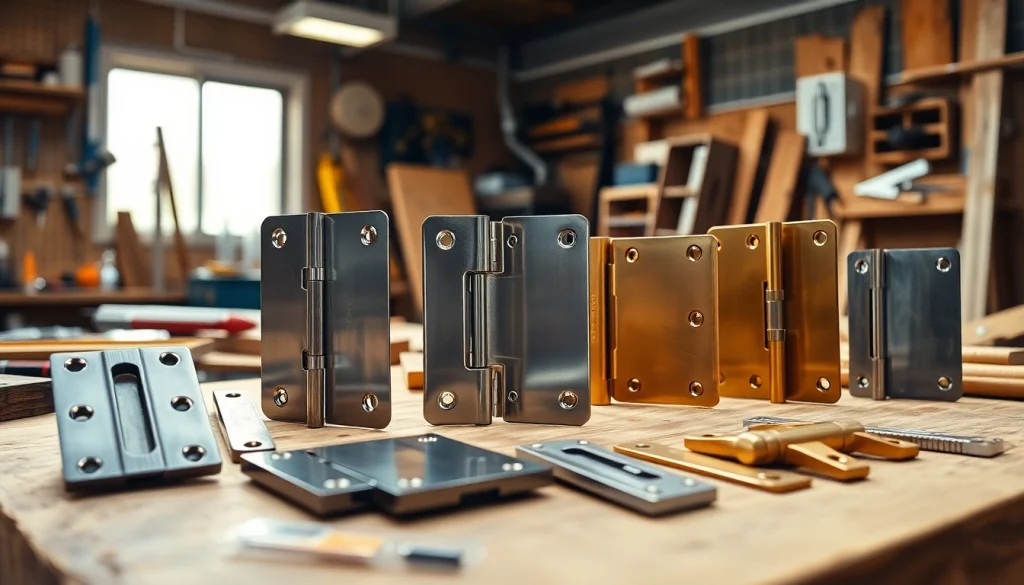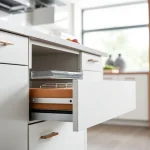1. Introduction to Cabinet Hinge Manufacturers
The functionality and aesthetics of cabinets are heavily dependent on the hinges that allow doors to open and close smoothly. For homeowners, cabinet designers, and builders, understanding the various types of cabinet hinge manufacturers is crucial in making informed decisions. Cabinet Hinge Manufacturers provide a vital link in the furniture design process, creating products that balance performance, style, and durability.
1.1 Overview of Hinge Types
Cabinet hinges come in various types, each designed with specific functionalities in mind. The most common types include:
- Concealed Hinges: These are hidden from view when the cabinet doors are closed, creating a seamless look. Often found in modern designs, they offer a clean aesthetic.
- European Hinges: A subtype of concealed hinges that allows for easy adjustment of the door after installation, making them ideal for kitchens and bathrooms.
- Pivot Hinges: Offering unique opening capabilities, pivot hinges allow cabinet doors to swing open in a fixed axis, often used in larger cabinet configurations.
- Soft-Close Hinges: These hinges slow the door’s motion before it closes, providing a gentle, silent closure that reduces wear and tear.
- Overlay Hinges: Designed for cabinet doors that overlap the cabinet frame, these hinges come in various sizes for different overlay requirements.
1.2 The Role of Hinge Manufacturers in Furniture Design
Manufacturers of cabinet hinges play a significant role in furniture design beyond simply supplying parts. They influence design trends and innovations. For example, leading hinge manufacturers like Blum and Grass have contributed to modern cabinetry aesthetics with their advanced hinge technologies, such as dampening systems that complete the user experience with their intuitive motion features.
1.3 Key Factors to Consider When Choosing a Manufacturer
When selecting a cabinet hinge manufacturer, several critical factors should be considered to ensure quality and performance:
- Product Variety: A manufacturer that offers a wide range of hinge types can accommodate various design needs and preferences.
- Quality Assurance: Understanding the quality control measures a manufacturer has in place will provide insight into the reliability of their product.
- Material Sources: Manufacturers who use high-grade materials are likely to produce more durable hinges.
- Innovative Features: Look for manufacturers that incorporate the latest technology, such as soft-closing mechanisms and adjustable options.
2. Types of Cabinet Hinges
2.1 Concealed Hinges: Features and Benefits
Concealed hinges are a favorite in modern cabinetry design due to their aesthetic appeal. They pivot on a hidden axis, which means they do not interfere with the overall appearance of the cabinet. The advantages of concealed hinges include:
- Visual Clarity: With no visible hardware when the door is closed, these hinges help maintain a clean look.
- Easy Installation: Many concealed hinges come with a template to streamline the installation process.
- Adjustability: Most concealed hinges allow for height, depth, and lateral adjustments after installation, meaning corrections can be made quickly and easily.
2.2 European Hinges: A Popular Choice for Modern Cabinets
European hinges, which are a subset of concealed hinges, dominate the cabinetry market due to their versatility and ease of use. They offer a range of features tailored to accommodate modern furniture trends, making them suitable for:
- Kitchen Cabinets: Commonly used in kitchens, they accommodate thick cabinet doors and provide easy access.
- Bathroom Storage: Their ability to handle frequent use makes them ideal for bathroom cabinets where durability is key.
- Wardrobes and Closets: European hinges offer a refined look that enhances furniture design in dressing rooms and closets.
2.3 Specialty Hinges: Soft-Close, Pivot, and More
In addition to standard hinge types, several specialty hinges cater to specific needs. Notable examples include:
- Soft-Close Hinges: These hinges automatically slow down and softly close cabinet doors, preventing slamming and offering safety features for children and pets.
- Pivot Hinges: Ideal for larger doors, these hinges allow for rotation around a fixed point, providing unique design possibilities.
- Bi-Fold Hinges: Used in foldable cabinet doors, allowing for expansive access while maximizing space utilization.
3. Evaluating Quality in Cabinet Hinge Manufacturing
3.1 Material Quality and Durability
The quality of materials used in hinge manufacturing directly impacts their durability and longevity. Common materials include:
- Stainless Steel: Renowned for its corrosion resistance, stainless steel is ideal for damp areas like kitchens and bathrooms.
- Brass: This material is often used for decorative cabinet hinges due to its aesthetic appeal and strength.
- Plastic Composites: While lightweight and cost-effective, plastic hinges are typically used for low-demand applications.
3.2 Examining Craftsmanship and Design
Quality craftsmanship denotes the precision with which hinges are designed and manufactured. Attention to details, like smooth edges and proper alignment, can differentiate a high-quality hinge. Furthermore, an ergonomic design can enhance usability, contributing to the overall functionality of the cabinet.
3.3 Comparing Cost Effectiveness and Value
It’s essential to weigh the cost against the value provided by a manufacturer. Low-cost options may initially seem attractive, but if they fail prematurely or lead to installation issues, they can result in greater long-term expenses. Evaluating warranty offerings, return policies, and customer service can also indicate a manufacturer’s commitment to quality.
4. The Manufacturing Process of Cabinet Hinges
4.1 Steps in the Production of High-Quality Hinges
The manufacturer must follow several steps to produce quality cabinet hinges. These steps typically involve:
- Material Selection: Choosing the right materials that meet both functional and aesthetic requirements.
- Design and Prototyping: Using CAD software to create designs, followed by prototyping before mass production.
- Machining: Cutting, drilling, and shaping the materials into desired components using precision machinery.
- Finishing: Applying coatings for protection and aesthetics, such as plating or painting.
- Assembly: Bringing together all parts and ensuring they operate correctly.
- Quality Control: Conducting rigorous testing to ensure durability and performance standards are met.
4.2 Technology and Innovation in Hinge Manufacturing
Innovative technologies significantly enhance hinge manufacturing, promoting efficiency and the ability to produce advanced mechanisms. Technologies such as:
- Robotics: Automation has revolutionized assembly lines, ensuring consistent quality and reducing human error.
- 3D Printing: Rapid prototyping enables faster design iterations and the creation of complex hinge mechanisms that were once difficult to manufacture.
- Sustainable Practices: Manufacturers are increasingly adopting eco-friendly materials and processes, appealing to environmentally conscious consumers.
4.3 Quality Control and Certification Standards
Stringent quality control measures are indispensable in hinge manufacturing. Many manufacturers adhere to industry standards such as:
- ISO Certification: Ensures that products meet international quality management standards.
- American National Standards Institute (ANSI): Establishes safety and performance benchmarks specific to hinges.
- Underwriters Laboratories (UL): Provides product testing and certification to guarantee consumer safety.
5. Future Trends in Cabinet Hinge Manufacturing
5.1 Eco-Friendly Materials and Sustainable Practices
As environmental concerns grow, manufacturers are increasingly focused on sustainability. This includes sourcing materials responsibly, reducing waste during production, and implementing recyclable packaging. These actions not only satisfy consumer demand for eco-friendly products but can also lead to cost savings in the long run.
5.2 Smart Hinges and Automation Technology
The integration of technology into cabinetry is on the rise, leading to developments like smart hinges that offer features such as automatic opening and closing via smartphone apps. This innovation appeals to consumers seeking convenience and enhances user experience in smart homes.
5.3 Adapting to Changing Consumer Preferences
As aesthetics and functionality continue to evolve, so does the need for hinge manufacturers to stay attuned to consumer trends. Preferences for minimalistic designs and multifunctional hardware are driving innovation. Manufacturers who can quickly adapt to these trends will remain competitive in the marketplace, continuously adapt their offerings to meet customer expectations.


